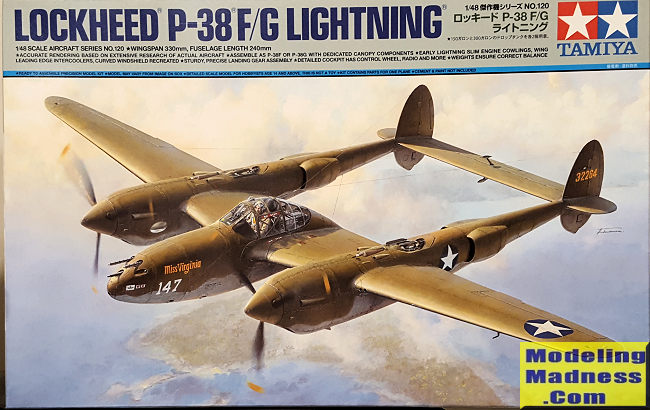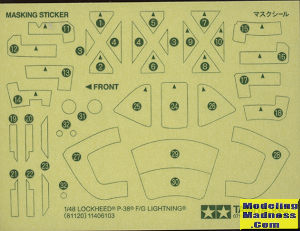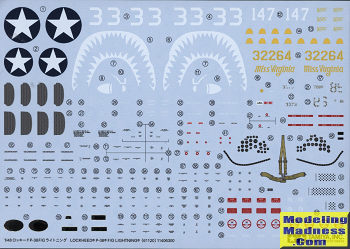
Tamiya 1/48 P-38F/G Lightning
| KIT #: | 61120 |
| PRICE: | $54.00 from Japan to my door. |
| DECALS: | Two options |
| REVIEWER: | Scott Van Aken |
| NOTES: | 2019 tooling |

| HISTORY |
After 210 P-38Es were built, they were followed, starting in February 1942, by the P-38F, which incorporated racks inboard of the engines for fuel tanks or a total of 2,000 lb (910 kg) of bombs. Early variants did not enjoy a high reputation for maneuverability, though they could be agile at low altitudes if flown by a capable pilot, using the P-38's forgiving stall characteristics to their best advantage. From the P-38F-15 model onwards, a "combat maneuver" setting was added to the P-38's Fowler flaps. When deployed at the 8° maneuver setting, the flaps allowed the P-38 to out-turn many contemporary single-engined fighters at the cost of some added drag. However, early variants were hampered by high aileron control forces and a low initial rate of roll, and all such features required a pilot to gain experience with the aircraft, which in part was an additional reason Lockheed sent its representative to England, and later to the Pacific Theater.
The aircraft was still experiencing extensive teething troubles as well as being victimized by "urban legends", mostly involving inapplicable twin engine factors which had been designed out of the aircraft by Lockheed In addition to these, the early versions had a reputation as a "widow maker" as it could enter an unrecoverable dive due to a sonic surface effect at high sub-sonic speeds. The 527 P-38Fs were heavier, with more powerful engines that used more fuel, and were unpopular in the air war in Northern Europe. Since the heavier engines were having reliability problems and with them, without external fuel tanks, the range of the P-38F was reduced, and since drop tanks themselves were in short supply as the fortunes in the Battle of the Atlantic had not yet swung the Allies' way, the aircraft became relatively unpopular in minds of the bomber command planning staffs despite being the longest ranged fighter first available to the 8th Air Force in sufficient numbers for long range escort duties. Nonetheless, General Spaatz, then commander of the 8th Air Force in the UK, said of the P-38F: "I'd rather have an airplane that goes like hell and has a few things wrong with it, than one that won't go like hell and has a few things wrong with it."
The P-38F was followed in June 1942 by the P-38G, using more powerful Allisons of 1,400 hp (1,000 kW) each and equipped with a better radio. A dozen of the planned P-38G production were set aside to serve as prototypes for what would become the P-38J with further uprated Allison V-1710F-17 engines (1,425 hp (1,063 kW) each) in redesigned booms which featured chin-mounted intercoolers in place of the original system in the leading edge of the wings and more efficient radiators. Lockheed subcontractors, however, were initially unable to supply both of Burbank's twin production lines with a sufficient quantity of new core intercoolers and radiators. War Production Board planners were unwilling to sacrifice production, and one of the two remaining prototypes received the new engines but retained the old leading edge intercoolers and radiators.
| THE KIT |
This kit has been strongly hyped as the best thing that has ever been done. Well, perhaps not that strongly, but it is exactly what one expects from Tamiya. This is a fairly fiddly looking kit with a lot of inserts, which strongly suggests other variations to be done. The F/G versions were the earliest truly combat ready P-38s and their combat use pointed out several areas of concern which led to H-L models that most of us are familiar with.
First, the cockpit is superbly done with two different instrument panels depending on which decal option you are building. It would have been nice if Tamiya had said "This is for the F and this is for the G", but they didn't. No where is the variant mentioned, other than the box top. Not even the markings guide. For those of us who like to use aftermarket decals, this would have been nice to know. After a bit of sleuthing, I discovered that the box art plane is a P-38G-13-LO, which was the second to last G model production batch. As the shark nosed plane has no serial (it was quite common in the Pacific and CBI to remove the serials), that must be the F.
The upper wing/fuselage/engine is a single piece with lots of reinforcements. There is a single wing spar that includes the nose gear well roof. One builds up the nose well, adds one of the three large bearings to the nose and closes things up. As a note, all three bearings were loose in the box, having escaped their plastic bag that is glued to the inside. Thankfully, there is no open weapons bay on this kit. One then continues to build this area up, including the various lights. Landing lights on these versions was under the wing. There is a cut out for the wing leading edge one used on later variants.
Turbocharger assemblies on each version are also different so pay attention. These apparently have to be installed prior to building up the tail booms. Tamiya has you build up each boom assembly separately so you don't get the wrong bits installed. Each boom has a receptical behind the prop for the other two bearings. Then one attaches the booms, slots the stab in place and holds it in place with the rudders.
 Landing gear doors are each two pieces and have very large
tabs on them so you can get a positive attachment. This is the major bugaboo of
other Lightning kits and shows that Tamiya thought this through. With the nose
gear assembly attached earlier it is now ready for the last bits. You have two
different droptank sizes, one requiring rear bracing. Then the rest of the
cockpit is completed. For clear bits you can have the canopy open or closed and
there are two styles of canopy. Tamiya provides paper masks to help you
out and they are much appreciated. Those not wanting to actually cut out each
mask will undoubtedly wait for Eduard to do a pre-cut one. Two pages and six
construction steps are dedicated to this. Last is building up the props,
attaching them and adding some smaller bits.
Landing gear doors are each two pieces and have very large
tabs on them so you can get a positive attachment. This is the major bugaboo of
other Lightning kits and shows that Tamiya thought this through. With the nose
gear assembly attached earlier it is now ready for the last bits. You have two
different droptank sizes, one requiring rear bracing. Then the rest of the
cockpit is completed. For clear bits you can have the canopy open or closed and
there are two styles of canopy. Tamiya provides paper masks to help you
out and they are much appreciated. Those not wanting to actually cut out each
mask will undoubtedly wait for Eduard to do a pre-cut one. Two pages and six
construction steps are dedicated to this. Last is building up the props,
attaching them and adding some smaller bits.

As usual, Tamiya provides a book to hold the 54 construction steps. A separate and very large fold out sheet is provided for the two markings options. One is the box art plane from the 339 FS/347 FG that partook in the shooting down of Yamamoto's Betty. The other is one based in New Guinea with the 39 FS/35 FG that has a nicely done shark mouth. Decals are very nicely done and include a belt decal in case you don't want to use the pilot figure. There are also chrome decals for the rear vision mirrors and the ovals on the inside of the engine nacelle so the pilot can tell if the nose gear is retracted or extended.
| CONCLUSIONS |
It is an excellent kit and one that anyone who wants to do an early P-38 will want to get. Does it send the previous kits into the dust bin or sales table. Depends on how competent a modeler you are. For most of us I'd say no, but for those who cannot stand to have 'old' kits in the stash, I don't doubt they will sell off their Academy and Hasegawa offerings. Good chance to pick those up for a song.
If you don't mind the somewhat high price one and can handle spending a while building it (it is a twin engine aircraft, after all), I think you will be quite pleased with this one.
| REFERENCES |
https://en.wikipedia.org/wiki/Lockheed_P-38_Lightning#P-38Fs_and_P-38Gs
November 2019 Copyright
ModelingMadness.com. All rights reserved. Thanks to me for the preview kit. If you would like your product reviewed fairly and fairly quickly, please
contact
the editor or see other details in the
Note to
Contributors.
Back to the Main Page
Back to the Review
Index Page
Back to the Previews Index Page